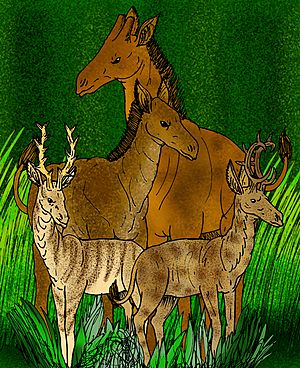Climacoceratidae facts for kids
Quick facts for kids Climacoceratidae |
|
|---|---|
 |
|
| Climacoceras africanus (left foreground), and C. gentryi (right foreground), with Palaeotragus primeavus (left background), and P. germaini (right background) | |
| Scientific classification |
|
| Kingdom: | Animalia |
| Phylum: | Chordata |
| Class: | Mammalia |
| Order: | Artiodactyla |
| Superfamily: | Giraffoidea |
| Family: | †Climacoceratidae Hamilton, 1978 |
| Genera | |
|
|
The Climacoceratidae were a fascinating family of ancient mammals. They looked a lot like deer, but they were actually close relatives of today's giraffes. These animals roamed Africa during a time called the Miocene epoch. This was a long time ago, roughly 23 to 5.3 million years ago!
Contents
What Were Climacoceratidae?
Climacoceratidae were ungulates, which means they were hoofed mammals. They belonged to a group called artiodactyls. This group includes animals like deer, cows, and giraffes. Imagine a deer-like creature with unique bony growths on its head. That's a good picture of a climacoceratid!
Ancient Relatives of Giraffes
For a long time, scientists weren't sure exactly where Climacoceratidae fit in the animal kingdom. They were first thought to be part of the Palaeomerycidae family. This family includes some ancient deer-like animals. Later, some were even grouped with giraffes! However, in 1978, a scientist named W. R. Hamilton realized they were special enough to have their own family. He created the family Climacoceratidae. He placed them in the larger group called Giraffoidea. This group includes both giraffes and their closest extinct relatives.
Their Unique Headgear: Ossicones
One of the most interesting features of Climacoceratidae was their headgear. Unlike deer, which grow and shed antlers every year, climacoceratids had permanent bony growths called ossicones. These ossicones were covered in skin and fur. They were just like those on modern giraffes.
However, there was a key difference! The ossicones of Climacoceratidae grew from different bones in their skulls compared to giraffes. This small but important detail helped scientists understand that they were a distinct family. They were unique, even though they looked similar to giraffes and deer.
Exploring the Climacoceratidae Family Tree
The Climacoceratidae family includes several interesting genera, or groups of species. Some of the known members are:
- Climacoceras: This is the main genus that gives the family its name.
- Nyanzameryx
- Orangemeryx
- Propalaeoryx
- Sperrgebietomeryx
These different genera show us the variety within this ancient family. Each one had its own unique features. But they all shared the common traits of the Climacoceratidae. Studying their fossils helps us learn more about how life on Earth has changed over millions of years.
See also
 In Spanish: Climacocerátidos para niños
In Spanish: Climacocerátidos para niños

